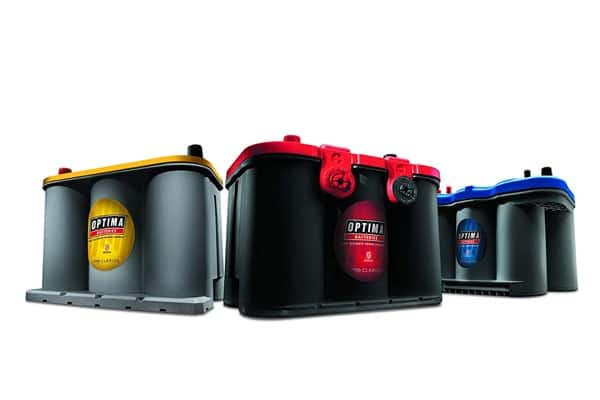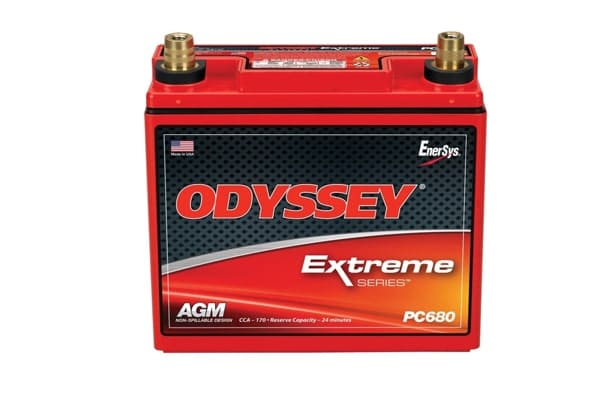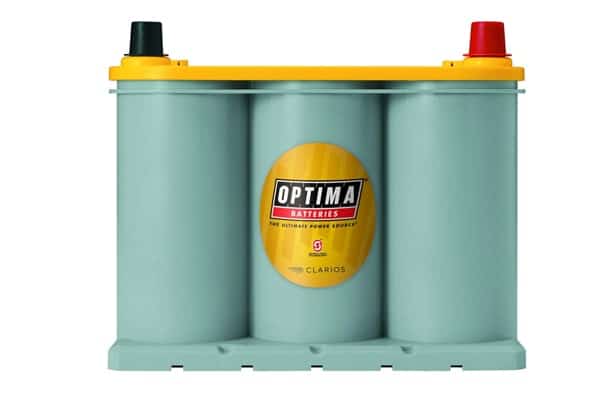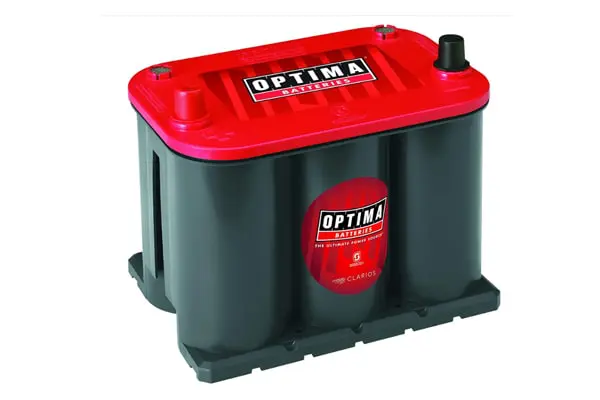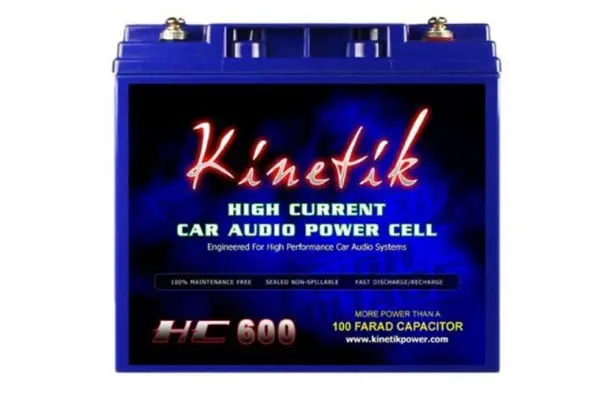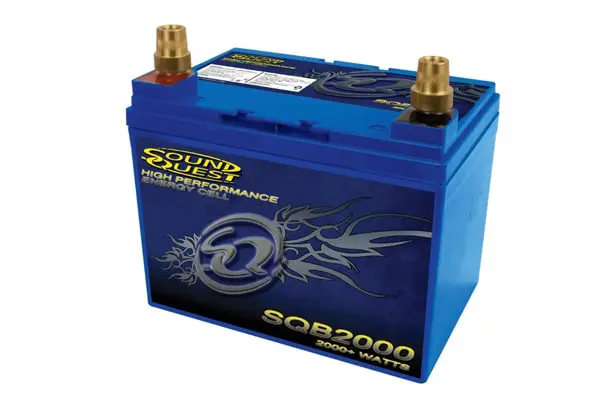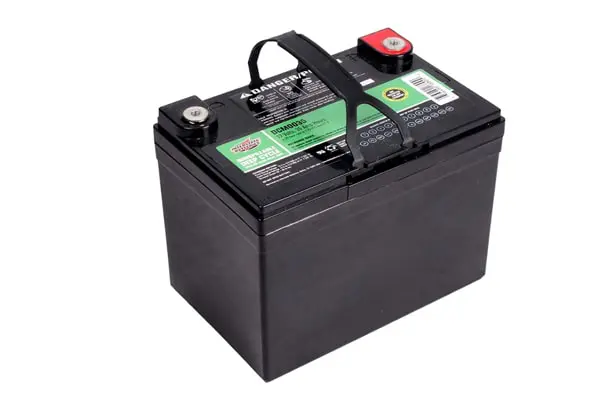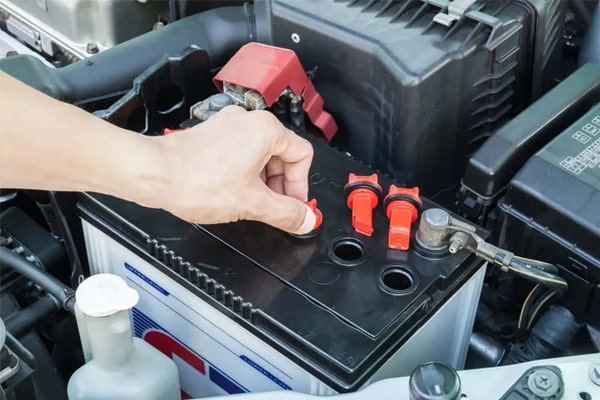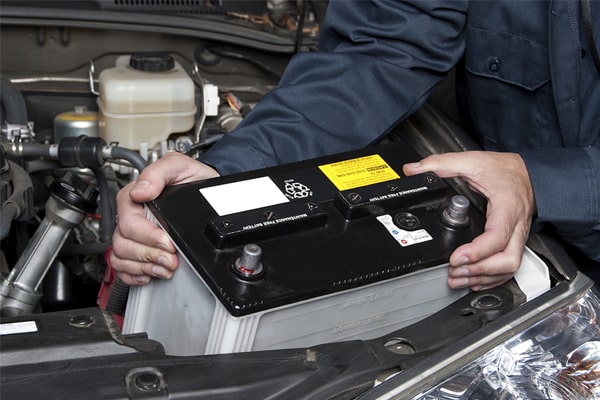Nothing’s more annoying than getting in your car only to find that the battery’s dead.
The day that your car battery finally gives in isn’t the day when you should start shopping for a new one. But according to my research – and a quick talk with friends and family members – that’s what most people would do.
Think about your current battery’s condition and age.
Is it time for a replacement?
If so, don’t risk getting stranded on the side of the road one day. I’ll help you choose the best car battery for your needs!
The 10 Best Car Batteries in 2020
1. Optima Batteries 8004-003
[su_button url="https://ift.tt/2Wyvlgo" target="blank" style="soft" background="#d60f17" color="#ffffff" size="7" center="yes" icon="icon: cart-plus" icon_color="#ffffff" text_shadow="0px 0px 0px #ffffff" rel="nofollow"]CHECK PRICE HERE[/su_button]
Optima Batteries already holds the title of one of highest-quality car battery brands; can you honestly say that you’re surprised to see their RedTop battery right at the very top of my list?
The thing that’s so impressive about this particular option is that it’s designed explicitly for high-powered starting, even when the weather conditions are less than ideal. After all, it does provide your vehicle with an intense burst of ignition power thanks to 800 cold-cranking amps.
Plus, you also get a 100-minute reserve capacity out of it!
The best part, however, is that its construction quality and durability are every bit as impressive as its specs:
Optima Batteries designed the 8004-003 with exceptional care, making it twice as durable and up to 15 times more resistant to common battery failure causes, such as vibration than a traditional lead-acid battery. And to add to it, it’s also maintenance-free and spill-proof.
So, you’re getting not only exceptional power but unmatched reliability, too!
As for the complaints, I don’t have many. Still, it’s pretty hard to ignore the fact that this is the most expensive car battery on the list.
Pros:
- Maintenance-free and leak-proof design
- 15 times more resistant to vibrations
- 800 cold-cranking amps for maximum start-up power
- Suitable for most stock vehicles
Cons:
- It’s quite expensive
| Yes, Optima Batteries 8004-003 is expensive, but it’s also a great vehicle battery for most stock vehicles – the best, even. When in doubt, go with Optima! |
2. Odyssey PC680 Battery
[su_button url="https://ift.tt/3bhb98j" target="blank" style="soft" background="#d60f17" color="#ffffff" size="7" center="yes" icon="icon: cart-plus" icon_color="#ffffff" text_shadow="0px 0px 0px #ffffff" rel="nofollow"]CHECK PRICE HERE[/su_button]
Let’s get back into the mid-range – dare I say, affordable – for a second and check out the best car battery for the price.
Seriously, though, the Odyssey PC680 is the battery for you if you’re looking for that price-to-value ratio. It’s not the cheapest, but it’s more than reasonably priced for the performance that it brings to the table.
The rugged, fully-sealed, leak-proof, AGM design can withstand shock and vibration much better than a conventional battery. But more impressively, the PC680 boasts a much longer battery life, and that’s what truly grabbed my eye:
Compared to a conventional battery, this one offers twice the overall power – and three times the battery life.
Best of all, you can expect it to survive up to 400 recharge cycles at an 80-percent discharge – all while ensuring outstanding recharge efficiency and reaching the 100-percent mark in four to six hours!
Granted, 170 cold-cranking amps isn’t that impressive, and I have to knock off some points for that.
But considering everything else – especially the 520 pulse hot cranking amps – I do think that this is still a good car battery for hot weather.
Pros:
- Can withstand up to 400 recharge cycles
- Extremely efficient recharge rates
- Rugged, shock- and spill-proof design
- Tolerant to extreme temperatures
Cons:
- Limited to 170 cold-cranking amps
| This battery saves money – both with the initial price tag and with its exceptional durability. If you want the best value car battery, this is it. |
3. Optima Batteries 8040-218 D35
[su_button url="https://ift.tt/3cjZQNM" target="blank" style="soft" background="#d60f17" color="#ffffff" size="7" center="yes" icon="icon: cart-plus" icon_color="#ffffff" text_shadow="0px 0px 0px #ffffff" rel="nofollow"]CHECK PRICE HERE[/su_button]
Yes, I already introduced you to one of Optima’s RedTop batteries, but I’m not done with Optima Batteries yet. Here’s the thing:
While they may seem relatively similar at first glance, the YellowTop battery – like the D35 that I have here – has very little in common with the RedTop one:
The Optima YellowTop is one of the very few genuine dual-purpose options on the market, and that’s what makes it such a good automotive battery.
If you drive a car that’s loaded with additional accessories and gadgets, all of which require extra power, this heavy-duty deep cycle battery could meet those power demands.
You’re getting reliable cranking power – even in cold weather – and unmatched cycling capability, plus a 98-minute reserve capacity.
And since it has such a low self-discharge rate, I found it to be perfect for seasonal use, too!
What’s more, I like how tough and durable this battery feels overall:
It relies on AGM technology and has a maintenance-free, spill-proof design. Furthermore, it’s up to 15 times more vibration-resistant than the competing options!
This YellowTop battery has lots to offer, but the not-so-affordable price tag is pretty hard to ignore. If you can afford it, give the RedTop a try!
Pros:
- Dual-purpose car battery
- Relatively low self-discharge rate
- Maintenance-free and spill-proof
- Vibration-resistant
Cons:
- Relatively pricey
| If you drive a car that’s chock-full of power-hungry accessories, don’t settle for any “regular” battery. The Optima YellowTop dual-purpose battery will be more up your alley. |
4. Mighty Max Battery ML35-12
[su_button url="https://ift.tt/3fyzFFj" target="blank" style="soft" background="#d60f17" color="#ffffff" size="7" center="yes" icon="icon: cart-plus" icon_color="#ffffff" text_shadow="0px 0px 0px #ffffff" rel="nofollow"]CHECK PRICE HERE[/su_button]
Mighty Max Battery – that right there is a name that promises a certain level of performance, doesn’t it?
But besides the catchy name, it gets a spot on my list because it offers some unique features that I’m used to seeing in some much more expensive options.
First off, it gets bonus points for exceptional construction quality – and at such an affordable price point, too.
It not only utilizes AGM technology in its design, but it is valve-regulated, spill-proof, and maintenance-free, too. You can mount the unit however you want and not worry about leaks. Plus, it’s also able to withstand quite a bit of vibration and shocks and works even in extreme temperatures.
The best part, however, is that this solar rechargeable battery uses calcium-alloy grids, known for being extremely heavy-duty. Thanks to this innovative feature, it delivers extended service life, a high discharge rate, deep-discharge recovery, and superior performance overall.
Also, this is one versatile little battery; the list of possible applications for the ML35-12 keeps growing by the day!
The only “downside” here is that it didn’t include mounting hardware or a wire harness.
Pros:
- Maintenance-free, spill-proof AGM design
- Calcium-alloy grid for cyclic and float applications
- Very versatile
- Operates in low and high temperatures
Cons:
- Doesn’t come with mounting accessories
| The Mighty Max lives up to its name; it’s one mighty battery, indeed. Best of all, it’s versatile enough to work with pretty much anything that requires battery power! |
5. Optima Batteries 8025-160
[su_button url="https://ift.tt/35KwJAR" target="blank" style="soft" background="#d60f17" color="#ffffff" size="7" center="yes" icon="icon: cart-plus" icon_color="#ffffff" text_shadow="0px 0px 0px #ffffff" rel="nofollow"]CHECK PRICE HERE[/su_button]
Surprise, surprise – yet another one of Optima Batteries products landed on my list. Then again, considering that Optima’s been at the forefront of battery innovations and engineering and has over 40 years of experience in making top-notch car batteries, can you blame me?
All jokes aside, though, I don’t want to turn this into a round-up of best Optima Batteries, and I promise that this is the last one. So, let’s make it count!
This one’s relatively similar to the RedTop battery that’s sitting right at the top of my list. You’re still getting a maintenance-free, spill-proof AGM battery with a 15 times higher resistance to shock and vibration.
The only difference is that it’s a tad bit less powerful when it comes to reserve capacity and cold cranking amps. That’s not to say that it’s underpowered in any way; you’re still getting a 90-minute reserve capacity and 720 cold-cranking amps for a powerful burst of ignition power.
However, I learned the hard way that the vehicle compatibility system is a bit off, so it took a bit more effort to get it to fit in the battery box. Other than that, I have no complaints.
Pros:
- Spill-proof, maintenance-free AGM battery
- Highly resistant to vibrations
- Delivers 720 cold-cranking amps
Cons:
- Vehicle compatibility system is a bit off
| If you want the RedTop’s best 12V battery at a somewhat lower price point, you won’t find a better deal than the 8025-160. |
6. ACDelco ACDB24R AGM Automotive Battery
[su_button url="https://ift.tt/2YM5J2z" target="blank" style="soft" background="#d60f17" color="#ffffff" size="7" center="yes" icon="icon: cart-plus" icon_color="#ffffff" text_shadow="0px 0px 0px #ffffff" rel="nofollow"]CHECK PRICE HERE[/su_button]
Now, I’m more of a truck kind of guy, but my next pick – ACDelco ACDB24R – is a great auto battery for anyone who drives a Prius. That’s only part of the reason why it gets a spot on my round-up, though:
ACDelco is a part of the General Motors Original Equipment line, and as such, finds its place in over two million cars every year!
So, I don’t think that there’s any doubt about this brand’s ability to create a high-quality car battery.
Much like any other reputable car battery manufacturer, ACDelco utilizes AGM technology, which doesn’t allow any spills or leaks. Most importantly, it makes the batteries maintenance-free.
Its durability and longevity are further backed up by the pressurized valve that prevents drying out or any potential acid damage.
Even more so, with 390 cranking amps – and 325 cold-cranking amps – and 70-minute reserve capacity, it doesn’t fall behind in the power department, either.
One thing worth mentioning is that it’s smaller than a regular-sized battery; compatibility may be an issue. As long as you double-check everything, you should be good to go, though!
Pros:
- An excellent choice for Toyota Prius
- AGM, leak-proof, maintenance-free battery
- Leak-proof pressurized valve
- Protects against drying out and acid damage
Cons:
- Compatibility may be an issue
- Not resistant to vibrations
| When it comes to the best 24F battery for Prius, you’ll be hard-pressed to find a better option than the ACDelco ACDB24R. |
7. DieHard 38188 Battery
[su_button url="https://ift.tt/2WhHCqU" target="blank" style="soft" background="#d60f17" color="#ffffff" size="7" center="yes" icon="icon: cart-plus" icon_color="#ffffff" text_shadow="0px 0px 0px #ffffff" rel="nofollow"]CHECK PRICE HERE[/su_button]
Did you seriously think that I wouldn’t include DieHard on my list?
You must know that I’m a die-hard fan – pun intended – of these batteries because they offer unmatched durability and sturdiness!
Besides the maintenance-free, leak-proof, AGM design – which is pretty much the industry standard these days – this one takes heat-sealed structural integrity to a whole new level:
You’re looking at 20 times more vibration-resistant battery – with a twice as long cycle life!
That’s why I recommend it for power-intensive users and those who drive off-road vehicles, performance cars, and other vehicles that experience much higher levels of vibration – something a regular battery would not be able to handle.
Plus, its power ratings are equally as impressive. In fact, with 775 cold-cranking amps and 120-minute reserve capacity, this is the most powerful car battery for the money.
It’s all about power and durability – and the best part is that it fits a wide range of vehicles, so compatibility shouldn’t be a problem.
Honestly, the only thing that I can complain about is that 44.5 pounds were a bit too much for my back.
Pros:
- Extremely rugged, maintenance-free, and leak-proof
- 20 times more resistant to vibrations
- For off-road conditions and trucks
- 775 cold-cranking amps
- 120-minute reserve capacity
Cons:
- Weighs over 44 pounds
| If you want the best truck battery for off-road conditions – one that’s insanely tough and rugged, with cutting-edge vibration resistance – the DieHard 38188 is it! |
8. Kinetik HC600 Battery
[su_button url="https://ift.tt/35MlszT" target="blank" style="soft" background="#d60f17" color="#ffffff" size="7" center="yes" icon="icon: cart-plus" icon_color="#ffffff" text_shadow="0px 0px 0px #ffffff" rel="nofollow"]CHECK PRICE HERE[/su_button]
Yes, yes, I know. Kinetik HC600 is a car audio battery; what’s it doing on a list of car batteries? Well, here’s the thing:
I’m positive that some of you happen to drive a powerful car fitted with an equally power-hungry sound system. And if that’s the case, you may want to stick around for the Kinetik HC600.
It may look relatively small and unassuming, but it packs a mean punch and can put out 600 cranking amps without breaking a sweat. That brings me to my next point:
Yes, this is primarily meant to be an affordable and reliable source of extra power for a high-performance, 600-watt aftermarket sound system. At the same time, though, it’s tough enough to jump in an emergency scenario, when your vehicle may need a replacement car battery.
All the internal components are sealed inside a reinforced ABS case, ensuring that it stays leak-proof and vibration-resistant at all times. Plus, it’s a maintenance-free car battery, too!
Again, remember that this is a car audio battery. If you need a primary one, then this isn’t it. Other than that, I have no complaints!
Pros:
- Cheap and lightweight
- Sealed AGM maintenance-free design
- Leak-proof and vibration-resistant
- An emergency replacement with 600 cranking amps
Cons:
- Can’t be used as a primary car battery
| For a powerful car with a power-hungry sound system, the choice is clear – the cheap and lightweight Kinetik HC600 is the way to go. |
9. SOUNDQUEST SQB2000 Battery
[su_button url="https://ift.tt/3fI6sb8" target="blank" style="soft" background="#d60f17" color="#ffffff" size="7" center="yes" icon="icon: cart-plus" icon_color="#ffffff" text_shadow="0px 0px 0px #ffffff" rel="nofollow"]CHECK PRICE HERE[/su_button]
If you want a battery that’s a bit more potent than the previously discussed Kinetik, then the SOUNDQUEST SQB2000 is the battery for you.
Even though it’s one of the more lightweight options at 22 pounds, this battery is capable of powering 2000-watt systems without breaking a sweat! If that’s not impressive, then I don’t know what is.
Seriously, that should be more than enough to supply the much-needed power to your car’s sound system, while also preventing issues that high-powered audio systems are known for causing – such as flickering lights.
Also, I like that it’s not particularly picky about how you recharge it. You can charge the battery using a 12V solar panel or a 12V alternative to a direct 120V power supply. Either way, the cell’s not going to complain. Plus, it can withstand over 300 full-discharge cycles!
Oh, and it comes with removable brass battery posts, which is a huge plus if you have any further customizations in mind.
The biggest downside is that it’s not vibration-resistant like the other options I tested. Plus, it doesn’t hold a charge well in off-season storage.
Pros:
- Suitable for 2000-watt systems
- Delivers 525-amp five-second burst power
- Multiple charging sources
- Removable brass posts
- Over 300 full-discharge cycles
Cons:
- Not vibration-resistant
- Not suitable for off-season storage
| The SOUNDQUEST is a compact battery that can power 2000-watt systems and put an end to your flickering lights. Overall, it’s an excellent secondary battery for the price. |
10. Interstate Batteries 12V Sealed Lead Acid (SLA) AGM
[su_button url="https://ift.tt/3ds7eHd" target="blank" style="soft" background="#d60f17" color="#ffffff" size="7" center="yes" icon="icon: cart-plus" icon_color="#ffffff" text_shadow="0px 0px 0px #ffffff" rel="nofollow"]CHECK PRICE HERE[/su_button]
Sure, it’s cheap; but the real question here is:
What else does this Interstate battery bring to the table – and is it worth it, in the first place?
Well, while I didn’t quite save the best for last with this one, there’s no denying that there are specific scenarios where a battery like this one – compact and as lightweight as 23 pounds – may come in handy.
It was designed for something a bit more different than the models you’ve seen so far. Sturdy and durable, it’s meant to be used mostly as a quick replacement or a power source for wheelchairs, scooters, and marine or trolling motors.
Any application where you will regularly discharge and then recharge your battery is more than welcome; it’s what this Interstate battery does best!
Plus, I love that it’s maintenance-free, resistant to spills and over-pressurization, as well as recyclable.
Unfortunately, though, the things that first grabbed my attention – the compact dimensions and lightweight construction – were also its biggest downfall. It can never deliver a performance as powerful as its bigger competitors.
Pros:
- Best suited for wheelchairs, scooters, trolling motors, etc.
- Has a carry handle for safety
- Maintenance-free and recyclable
- Small-sized, lightweight battery
Cons:
- Not as powerful as larger batteries
- Limited applications
| The Interstate is an excellent purchase if you need a small, light, and portable battery that won’t weigh you down, but can still power your trolling motor, wheelchair, or RV when required. |
What Is A Car Battery And Who Makes The Best Ones?
If you came this far, it’s safe to assume that you have a pretty good understanding of what a car battery is, so I’ll try to keep things as short and straightforward as possible.
In essence, a car battery is a rechargeable power source that meets the specific power requirements of your vehicle’s electrical systems.
On that note, the primary function of any car battery is to start the car, power the ignition, and operate the lighting. Other than that, they can also provide electricity to all sorts of gadgets, including the car’s stereo system, navigational equipment, as well as other OEM and aftermarket accessories.
More often than not, car batteries have plastic housing with two terminals on top that act as connection points for the car’s electrical system; it doesn’t get much more straightforward than that.
As for the best manufacturers of car batteries, I can’t give you a single name; that wouldn’t be fair.
Instead, I’ll give you a list of brands that you can turn to for powerful performance, longevity, and exceptional overall quality:
- Optima Batteries
- Odyssey
- ACDelco
- DieHard
- Bosch
Why Do You Need A Car Battery?
A car battery isn’t some optional extra or accessory for your car. Instead, it’s a critical part of any vehicle, acting as a rechargeable energy source for the car’s electrical system.
Without it, your car would – quite literally – be left at a standstill.
So, to help you understand the importance of a good car battery, I wanted to take a moment to list a few reasons why you need one in the first place.
- Starting – That first half-turn of the key in the ignition that wakes up your car – that’s your car’s battery at work. Even though your engine hasn’t started yet, you can still turn on the interior lights, run the air vents, listen to the radio, and check the dashboard indicator lights, all thanks to the battery.
- Lighting – The rear and main headlights, interior lights, and all the indicator lights are powered directly by the car battery. That’s what allows you to park your car, turn off the engine, and still have the lights turned on for visibility. Other electrical components and devices that can plug into the 12V power outlet all rely on the battery as their power source.
- Ignition – Your car’s engine doesn’t just start by itself; it needs a little electrical push to get going. The spark plugs and heating elements rely on the battery for that bit of electricity that will light the fuel inside the engine and get things going.
How Does Car Battery Work?
Even though there were many technological advances made throughout the years, the basics of how car batteries work haven’t changed much:
They work as portable power-generating units that lend your vehicle – and all its systems – the necessary electrical power. And they do so by converting the energy that’s released in chemical reactions into electrical energy:
Whenever you half-turn the key in the ignition, a chemical reaction occurs, releasing on-demand power to the vehicle’s electronic components.
In most cases, car batteries will rely on lead-acid chemical reactions – a reaction between lead plates and the acid or electrolyte inside the cell – to generate electricity and get things going, delivering a jolt of energy to the car’s electronics.
Types Of Car Batteries
Car batteries can, broadly speaking, be categorized into two primary groups:
Lead-Acid (Regular) Batteries
Unlike the more traditional flooded cell batteries, which required the water in the electrolyte solution – the battery’s power source – to be topped off periodically, the new lead-acid batteries don’t need this type of maintenance:
They are designed with caps that shouldn’t be removed and typically retain their fluid throughout the battery’s entire lifecycle. Hence, they’re often referred to as “maintenance-free.”
One of their benefits is that they’re cheap; as such, they’re the more commonly used type. Then again, they don’t tolerate a deep discharge as well and may not hold a charge for as long as their AGM counterparts.
Absorbed Glass Mat (AGM) Batteries
Compared to standard batteries, the AGM ones are designed to withstand repeated draining and recharging cycles. Plus, they pack some outstanding features for safety and convenience, allowing them to meet the power demands of fuel-saving stop-start systems, electronic security, and dedicated power outlets for mobile devices.
If you leave your car parked for more extended periods and are worried about the battery losing its charge, an AGM one is a smart choice. They can tolerate a deep discharge and is more likely to recover fully.
On the flip side, they cost a lot more than lead-acid batteries; be sure to factor in your budget.
How To Choose A Car Battery: Buying Guide
It would be a shame if I let you leave today without sharing a few essential tips for choosing the highest-quality car battery for the money with you. Making an informed purchase means learning about the factors that are at play here.
The first and most crucial one among them is choosing the right car battery for your specific vehicle.
Your car can only use a specific battery; getting the right fit is non-negotiable. So, to avoid any unnecessary complications, always check the dimensions – height, width, as well as length – and the terminals to determine whether it will be a good fit.
On that note, here’s a quick overview of the most common battery sizes:
- Size 24/24F (Top Terminal) – Toyota, Honda, Acura, Nissan, Infiniti, Lexus
- Size 34/78 (Dual Terminal) – 1996-2000 General Motors trucks, large Chrysler vehicles, SUVs, sedans
- Size 35 (Top Terminal) – Recent Japanese cars, including Toyota, Nissan, Honda, and Subaru
- Size 47 (H5) (Top Terminal) – Chevrolet, Buick, Volkswagen
- Size 48 (H6) (Top Terminal) – American and European vehicles, including Buick, Audi, BMW, Mercedes, GMC, Mini, Chevrolet, Volvo, Cadillac, Volkswagen, and Jeep
- Size 49 (H8) (Top Terminal) – Asian and European cars, including Audi, BMW, Hyundai, and Mercedes-Benz
- Size 51R (Top Terminal) – Honda, Mazda, Nissan
- Size 65 (Top Terminal) – Mercury, Lincoln, and Ford trucks, SUVs, and large cars
- Size 75 (Top Terminal) – Midsize and compact cars from GM and Chrysler
Next, you should focus on getting the right set of specs that will not only meet the needs of your car but work with your driving habits, too.
The four main performance-related factors to look out for before you buy a new car battery are:
- Cranking Amps – This rating shows you the power that the battery can deliver to the engine at average temperatures – 32 degrees Fahrenheit, to be exact – for 30 seconds. It’s the essential specification to check when shopping for the best replacement car battery.
- Cold Cranking Amps – As opposed to cranking amps, the CCA rating is a measurement of how well the battery at hand can start the engine in freezing weather. More specifically, it indicates the battery’s ability to crank the vehicle’s engine for 30 seconds at 0 degrees Fahrenheit.
- Battery Life – Much like any other type of battery, car batteries can be discharged and recharged for a set number of times before their performance starts to deteriorate. That said, other factors can affect the battery’s life, such as exposure to extremely high temperatures, starting the engine frequently, and the length of your trips.
- Reserve Capacity – This indicates how long the battery can last if one of the components in the charging unit fails or you leave your headlights on by accident. In essence, it measures how long a battery that’s operating at 80 degrees Fahrenheit would be able to deliver 25 amps continuously before the voltage drops to 10.5V.
Most batteries will, on average, have 90-minute reserve capacity.
The third and final piece of advice I will give you is always to check the “freshness” of the battery.
Even if they’re stored adequately, car batteries lose their charge over time. You shouldn’t waste money on a battery that’s been sitting on a shelf for some time now. Get a battery that was made recently – within the last six months.
You’ll find the essential info regarding the unit’s “freshness” on the cover, where the date stamp code is.
Car Battery – Frequently Asked Questions
1. Which brand of the car battery is the best?
It’s hard to highlight one manufacturer of car batteries as better than the others; there isn’t a single best car battery brand. That said, there are certainly some manufacturers that are widely recognized in the world of car batteries for their premium-quality products.
The brands that I’m most comfortable with recommending are Optima, Odyssey, DieHard, ACDelco, as well as Bosch.
But rather than focusing on finding the best brand or the best place to buy a new car battery, you should try and pick one based on the things discussed in our buying guide.
2. Which car battery lasts the longest?
Lithium-ion batteries are leaders when it comes to their life expectancy. Compared to a regular lead-acid battery, which lasts three to five years on average, a lithium-ion one can hold up for up to 10 years.
That’s because these batteries have high-energy-density, low-discharge capability, and a high level of charging efficiency. In short, they last longer, recharge faster and lose less energy overall.
3. Is Interstate a good car battery?
The real question regarding Interstate Batteries, like the one I showed you earlier, isn’t whether or not they’re “good.” Instead, you should ask yourself whether or not it’s suitable for your specific uses.
They’re excellent for instances where they’ll be recharged and discharged regularly and can be used as a power source for mobility scooters, wheelchairs, and trolling motors. They don’t hold enough power for car engines, though.
4. How do I choose a car battery?
As discussed previously, when choosing a car battery, the first crucial step is to inform yourself about your car’s specific battery requirements. If you get that right, you’re golden; all that’s left to do then is pick a reputable brand, check the “freshness,” and find something that fits within your budget.
5. Are expensive car batteries worth it?
There are some pretty good car batteries on the market that will cost you anywhere from $50 to $120 on average. However, if you want premium quality and performance, you should be ready to pay more than that. These high-end options often have price tags of well over $200.
We would all like to save a few dollars here and there, but buying a new car battery isn’t exactly the best time for cutting costs. An expensive car battery will almost always be a worthwhile investment; a cheap one seldom is.
6. When should you replace your car battery?
The average car battery life is around five years, but this hugely depends on your driving habits and possible exposure to extreme elements, among other things. After the five-year mark, though, you should be looking for a replacement.
A few tell-tale signs are your car engine struggling due to the lack of cold-cranking power, the battery indicator on the dashboard turning on, and the battery going flat even though it was fully charged a few days ago.
Conclusion
That was quite a read, huh?
Now, you know that I always encourage you to follow your gut – your car, your rules – but I’d like to put my two cents in before I bring this best car battery round-up to an end.
This time around, it’s a tie between the Optima Batteries 8004-003 and the Odyssey PC680 Battery. The former is an excellent choice in every way imaginable – but an expensive one – while the latter is much easier on the wallet.
Either way, I think your car’s engine and electronics will be happy!

